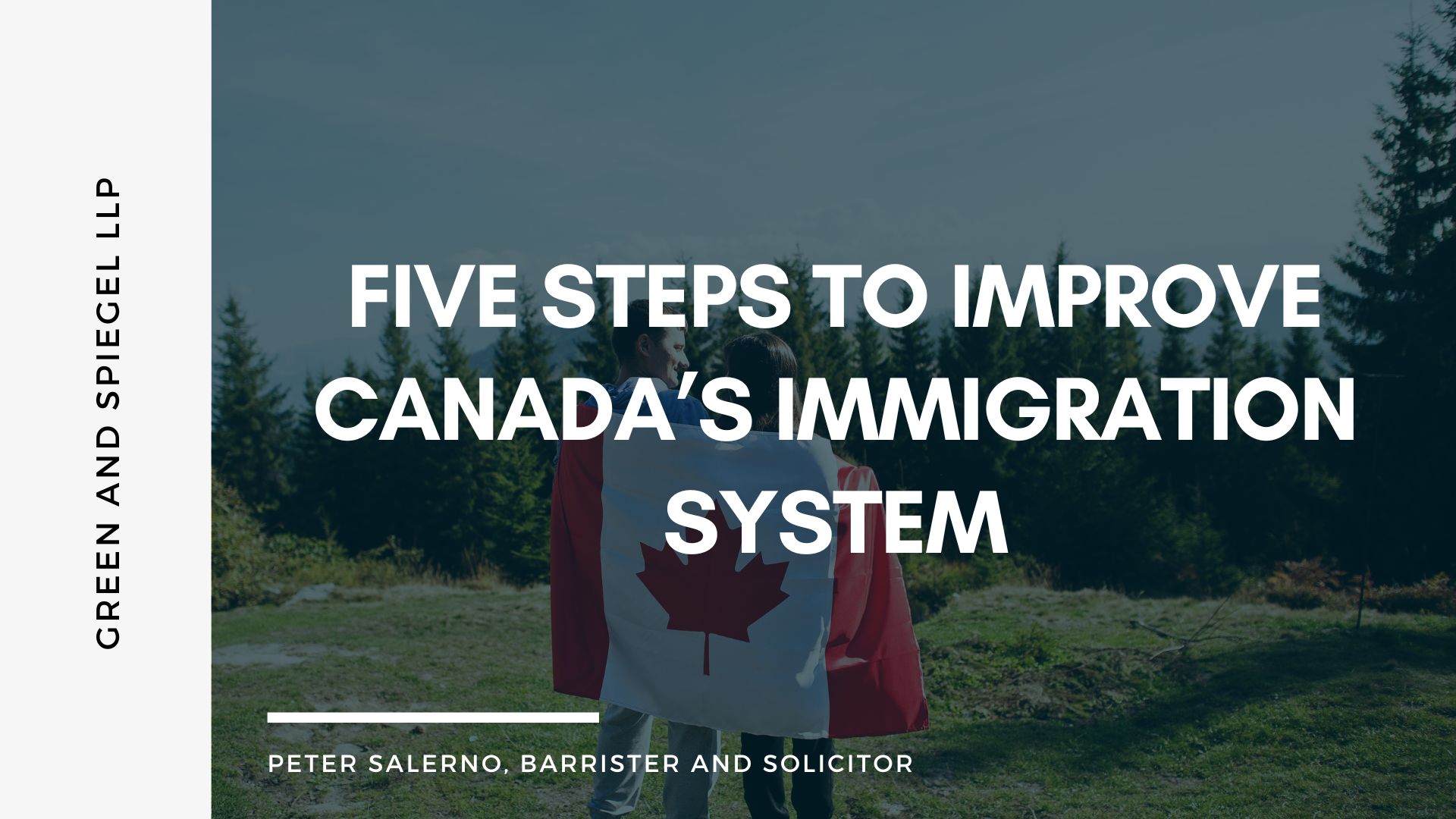
The Canadian government and its overseas offices are taking a long time to render decisions on most types of applications. The government confirmed this, recently, disclosing that there are about 1.3 million applications in process that have exceeded service standards.
Whether having applied for Canadian citizenship or to enter Canada as an immigrant, worker, student or visitor, processing times have remained lengthy and unpredictable since almost the start of the COVID-19 pandemic – much to the chagrin of countless Canadians and foreign nationals alike who are feeling increasingly left in the dark as their or their loved ones’ applications are processed for months and sometimes years without any substantive updates from Immigration, Refugees and Citizenship Canada (“IRCC”).
IRCC does not seem oblivious to the swelling tides of frustration. Some steps have been taken to enhance responsiveness and cut down processing times; for instance, IRCC is in the process of expanding its use of online application processes for permanent and temporary residence that are aimed at simplifying and speeding up application processes. But these measures take time to yield fruitful results and are, moreover, accompanied by frequent growing pains. There is a pressing need for IRCC to do more, more quickly. To that end, the following steps are being proposed.
1. Reduce processing times – implement broader use of electronic travel authorization for visa-required foreign nationals
Presently, only visa-exempt foreign nationals can apply online for an Electronic Travel Authorization (“eTA”). The process is simplified and paperless; if the application is approved, usually within minutes after submission, the eTA is electronically linked to the traveller’s passport.
A foreign national who is a citizen of a visa-required country, on the other hand, must submit multiple forms and supporting documentation, then wait for a passport request letter from an overseas Canadian consulate, high commission or embassy where their application was processed. Upon receipt of the passport request letter, only then can the applicant drop off or courier their original passport to the closest Canadian Visa Application Centre (“VAC”), after which a Temporary Resident (“TR”) or Permanent Resident (“PR”) visa counterfoil is affixed in their passport and the passport returned to them.
The difference is notable and significant: unlike the visa-exempt foreign national applying online for an eTA, the visa-required foreign national must submit sometimes significant documentation as well as their original passport so the TR or PR visa can be affixed in their passport. This step alone adds at least three to five business days, almost invariably more, and this is after their application is already approved.
Perhaps the current system in place for visa-required foreign nationals is simply the way things have been done in the past and IRCC has not yet been able to modernize the process. Or perhaps there are some benefits to affixing an original visa counterfoil into a passport, such as enhancing IRCC’s ability to perform security verifications on an original passport. But is difficult to contemplate why the current process remains necessary for all visa-required foreign nationals in light of the relatively efficient system in place for visa-exempt foreign nationals applying for an eTA.
The mire of current processing delays should compel IRCC to re-think processes for visa-required foreign nationals and adopt a form of electronic travel authorization for at least some.
More specifically, if certain objective criteria are met, select visa-required foreign nationals should be considered a “trusted traveller” or receive some other type of designation that would render them eligible for a simplified online application process for electronic travel authorization linked to their passport. Potential criteria could involve, for instance, them having been issued a US or Canadian visa within the prior ten years.
If IRCC is unwilling or unable to implement this kind of trusted traveller program, surely electronic authorization could be made available for visa-required foreign nationals with an approved application rather than them providing IRCC their original passport and waiting for its return with the TR or PR visa counterfoil.
The broader use of electronic travel authorization for some visa-required foreign nationals, or at a minimum in the instance of applications that have been approved, would be of enormous significance for many who are waiting overseas to travel to Canada to begin their studies, employment or life, and time becomes of utmost importance after usually weeks, months or years of their applications processing.
2. Improve communication for Permanent Resident (“PR”) Card applicants – request confirmation of an applicant’s whereabouts in the call-in notice if a PR Card must be picked up in person
For most permanent residents living inside Canada who are renewing or replacing their permanent resident cards, they will not need to pick up their card in person. IRCC will mail the new PR card to the address listed in their application.
Some applicants, however, will be required to pick up their new PR card in person at an IRCC office located inside Canada. When this occurs at IRCC’s discretion, a particular day and time are stated on the initial call-in notice for the Applicant to pick up their PR card.
The problem arises when applicants receive this call-in notice, and they happen to no longer physically reside in Canada at that time. While some may have been planning to return anyway or be able to put their lives on hold overseas and promptly re-enter Canada by land via the US to make the scheduled appointment, others will need to apply for a Permanent Resident Travel Document (“PRTD”). In that case, they will rarely be able to attend the appointment time noted in the call-in notice through no fault of their own as they wait for the issuance of their PRTD (which coincidentally requires all foreign nationals to submit their original passport the closest VAC). Such applicants will need to contact IRCC, informing IRCC that they will be unable to attend their appointment pending the issuance of their PRTD.
There is significant (and needless) back and forth between applicant and IRCC, with the current system causing considerable stress for applicants and additional administrative work for IRCC. Applicants in this scenario do not typically receive a response from IRCC quickly about the re-scheduling of their appointment and, when they do, they are given a second call-in notice with another specific date and time. To make matters worse, the PRTD is sometimes not issued in time for applicants to attend even the rescheduled second appointment.
When a PR card must be picked up in person, it would be far more helpful for the IRCC call-in notice to simply inform the applicant of the requirement for in person pick up and request confirmation that applicant is either inside Canada or that they are outside of Canada. If the latter, the applicant should be requested to inform IRCC if and when they have a valid PRTD. IRCC can schedule the appointment once the applicant confirms they are inside Canada or are otherwise travel ready.
If IRCC is concerned about the PRTD application process dragging on longer than 180-days, thereby allowing the PR cards in Canada to be destroyed by law, then IRCC can simply state this timeline on the letter sent to applicants informing them of the need to pick up their card in person. It may motivate applicants to apply quickly for a PRTD and return to Canada within this timeframe. IRCC should also shorten the processing times for PRTDs; these are Canadians stuck overseas with sometimes no way to return home.
The current call-in notices stating a specific date and time for applicants to pick up their PR cards in person benefits no one and needlessly complicates the process. IRCC should not assume applicants remain physically residing in Canada during what has lately been a months-long lifespan of an application to renew or replace a PR card.
3. Enhance efficiency of the IRCC Webform – inform clients which IRCC office is processing their application
One of the most used channels of communication with IRCC is the IRCC Webform. Besides the IRCC Call-Centre, where it is notoriously challenging as of late to connect with an agent, submitting a webform is sometimes the only way to “speak” with IRCC once an application is submitted to IRCC.
A person can populate and submit a webform online to provide, by way of example, new information in relation to a pending application for Canadian citizenship, immigration, PR card renewal, work permit, study permit or TR visa. A webform can also be used amongst other purposes to upload additional evidence in relation to a pending application.
Typical response times from IRCC’s Client Support Centre agents fluctuate; at present it’s approximately four to six weeks. Anyone filing a webform will be told by IRCC, however, to expect delays due to the high volume of webforms being filed.
IRCC must better this situation – there are frequently time sensitive inquiries sent via webform, such as a material change of circumstances, that require more immediate action from IRCC.
IRCC could improve transparency for applicants, shorten response times and alleviate the burden on Client Support Centre agents by simply informing applicants which IRCC office is processing their application. This information is not currently disclosed but could be readily conveyed when IRCC provides an applicant with acknowledgment their application has been received. If this information was given, then, applicants could direct their inquiries directly to the IRCC office responsible for processing their application, rather than having this information submitted via webform sit needlessly until a Client Support Centre agent has an opportunity to forward it to the responsible office.
In addition to confirming which IRCC is responsible for processing the application, the acknowledgement letter could also state that the IRCC Office may be transferred to other offices for most efficient processing, and if another office becomes responsible for processing, the applicant will be notified.
It is baffling why Client Support Centre agents are presently acting as intermediaries for most inquiries sent to IRCC – applicants having to use the general IRCC Webforms adds a pointless layer between applicants and the IRCC officers that are actually processing their applications. It also leads to a higher volume of webforms having to be processed by IRCC’s Client Support Centre agents, thereby increasing the administrative burden, and leading to longer response times.
This seemingly simple solution would avoid clogging up the IRCC Webform, and hopefully lead to faster, more substantive responses from Client Support Centre agents.
4. Reduce confusion for temporary foreign workers in Canada who have submitted applications to extend their status
When most applications are submitted to IRCC, the applicant will be issued a standard letter that states the date on which IRCC received the application. Applicants are normally pleased to receive this acknowledgement of receipt letter because it reassures them the processing of their application is underway.
However, temporary foreign workers in Canada who file extension applications have been receiving these letters with some additional, confusing wording.
If the applicant submitted their extension application before the expiry date of their work permit, the letter firstly confirms receipt of the application and, secondly, that the foreign national will continue to hold work authorization after the expiry date of their current work permit until a prescribed date, typically five or six months in the future.
The problem arises, and frequently due to processing delays, in the scenario where the discretionary end date listed in the IRCC letter comes and goes, but the extension application remains in process. Applicants end up asking themselves, “Can I continue working in Canada while my application is pending?”
IRCC should get rid of this confusion for temporary foreign workers in Canada by removing that end date in the acknowledgement of receipt letters – by law, there is no end date as to when maintained status and work authorization necessarily expires if the foreign national remains in Canada while waiting for a decision on the extension application. Work authorization will normally continue until a decision is made on the pending extension application.
5. Refrain from making announcements about future announcements
As noted earlier, IRCC has introduced a series of new, timely and exciting changes. For instance, there were policy changes to make it simpler for temporary residents in Canada during the pandemic to apply for work permits or otherwise obtain work authorization, rather than forcing them to apply from overseas. Creation of the temporary resident to permanent resident pathway also comes to mind, which was another new, timely option for temporary residents who were working in Canada to apply for their immigration.
IRCC’s new programs and policies have been laudable in many cases yet the rollout too often seems disjointed. This could be fixed at least in part by IRCC refraining from making announcements about upcoming programs or changes unless there is basic information available such as eligibility criteria, what type of impact it will have and when the changes will come into effect. Without this basic information, foreign nationals are left in the dark and sometimes for months to speculate when new changes will be implemented and whether they stand to benefit from them.





